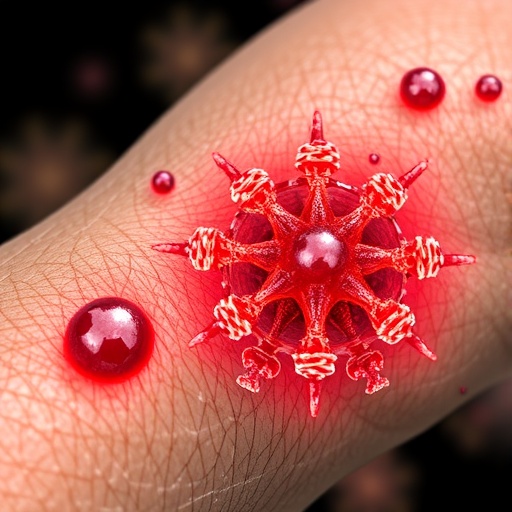
In a groundbreaking advancement that could revolutionize the treatment of neovascular eye disorders, a team of researchers led by Ang, Thura, and Tan has unveiled the potential of a novel therapeutic agent, PRL3-zumab. Published in the prestigious journal Nature Communications, this study delves deeply into the anti-angiogenic properties of PRL3-zumab, offering new hope for millions affected by sight-threatening conditions such as age-related macular degeneration and diabetic retinopathy. The implications of this research are vast, suggesting a future where vascular growth in the eye can be precisely regulated, reducing disease progression and preserving vision.
Neovascular eye diseases are characterized by abnormal blood vessel growth, which often leads to leakage, hemorrhage, and ultimately, irreversible vision loss. Conventional therapies have primarily focused on inhibiting vascular endothelial growth factor (VEGF), a key driver of angiogenesis. However, resistance and incomplete responses remain significant challenges, prompting scientists to explore alternative molecular targets. The study helmed by Ang and colleagues introduces PRL3-zumab, a monoclonal antibody, which targets the phosphatase of regenerating liver 3 (PRL3), a protein recently implicated in pathological angiogenesis within ocular tissues.
The research team embarked on an exhaustive molecular investigation to elucidate the mechanisms by which PRL3 contributes to neovascularization. Their findings revealed that PRL3 acts as a critical facilitator of endothelial cell migration and proliferation by modulating multiple intracellular signaling pathways. These insights allowed the identification of PRL3 as an actionable target, overcoming limitations posed by existing anti-VEGF treatments. PRL3-zumab binds selectively to PRL3, effectively neutralizing its pro-angiogenic activity, thereby suppressing aberrant vascular growth at a cellular level.
To validate the therapeutic efficacy of PRL3-zumab, the researchers employed a series of preclinical models, including in vitro cultures of retinal endothelial cells and in vivo animal models exhibiting neovascular pathology. Across these platforms, PRL3-zumab demonstrated robust inhibition of new blood vessel formation without significant off-target effects. Notably, the treatment led to marked reductions in vascular leakage and fibrovascular membrane formation, common pathological hallmarks in neovascular eye disease. This evidence highlights PRL3-zumab’s dual capacity to both halt angiogenesis and stabilize existing vascular structures, a crucial factor for preserving retinal integrity.
Moreover, the study delves into the biochemical interactions underpinning PRL3-zumab’s function. PRL3 possesses phosphatase activity that alters the phosphorylation status of substrates involved in endothelial cell motility and survival. By binding to extracellular domains associated with PRL3, PRL3-zumab effectively impedes these enzymatic processes. This disruption curtails downstream signaling cascades, notably the PI3K/AKT and MAPK pathways, which are instrumental to angiogenic responses. Detailed crystallographic analyses revealed the antibody’s binding epitopes, offering insights for future optimization of therapeutic specificity and affinity.
In the context of neovascular eye diseases, the onset and progression are often exacerbated by inflammation and hypoxia-driven cellular stress. PRL3 expression was shown to be upregulated under such pathological stimuli, amplifying the angiogenic drive. Therefore, PRL3-zumab’s ability to modulate this inducible protein paves the way for therapeutic intervention precisely when pathological angiogenesis peaks. This temporal targeting could translate to more effective disease management, minimizing adverse effects observed with chronic VEGF inhibition, such as neuroretinal toxicity or geographic atrophy.
One of the striking features of PRL3-zumab is its promising safety profile. The study detailed comprehensive toxicological assessments indicating minimal immunogenicity and absence of systemic complications following administration in animal models. Importantly, localized delivery to the ocular environment ensured targeted action with negligible systemic absorption. This localized effect is particularly advantageous for eye diseases, where preserving surrounding healthy tissues is essential. The team’s data thus points toward a scalable, patient-friendly treatment modality that could potentially be administered via intravitreal injections similar to current standards.
The application horizon of PRL3-zumab extends beyond suppression of neovascularization; it also encompasses preventive strategies. Early intervention with PRL3-zumab in models mimicking preclinical stages of disease effectively blunted the onset of vascular abnormalities. This prophylactic potential is vital for chronic conditions where vascular dysfunction precedes overt clinical symptoms. The concept of prophylactic treatment could transform therapeutic paradigms, shifting focus from reactive management to proactive prevention, thus preserving vision before irreversible damage occurs.
In a broader biomedical context, phosphatase-targeting antibodies like PRL3-zumab represent an emerging frontier in drug discovery. Historically, phosphatases have been considered “undruggable” due to their conserved enzymatic pockets and structural dynamics. The success of PRL3-zumab challenges this notion, showcasing that precise antibody engineering can yield potent inhibitors capable of modulating key intracellular actors. This breakthrough holds promise not only for ophthalmology but also for oncology and vascular medicine, where pathological angiogenesis and proliferation are prevalent issues.
The study also highlighted the potential for combination therapies. PRL3-zumab could synergize with existing anti-VEGF drugs to overcome resistance and enhance treatment outcomes. Combination regimens may reduce the required dosage of VEGF inhibitors, mitigating their side effects while enhancing efficacy. Preliminary results from co-treatment models demonstrate additive suppression of neovascular lesions and improved functional retinal preservation. Such multidimensional therapeutic strategies could forge new paths in personalized medicine tailored to individual disease phenotypes.
Importantly, this research underscores the significance of translational science in ophthalmology. By bridging molecular biology, immunology, and clinical pathology, the team has crafted a therapeutic candidate ready for clinical trials. Their rigorous methodology, from molecular characterization to animal studies, ensures a robust foundation for subsequent human testing. The anticipation surrounding PRL3-zumab is tangible, as it may fill critical unmet needs in managing eye diseases that remain leading causes of global blindness.
As clinical translation proceeds, several challenges must be addressed. Pharmacokinetics, dosing schedules, and long-term safety will be subjects of intense investigation. Additionally, identifying biomarkers predictive of treatment response could optimize patient selection, enhancing therapeutic success rates. The researchers advocate for collaborative efforts involving ophthalmologists, immunologists, and pharmaceutical developers to accelerate the journey from bench to bedside. If successful, PRL3-zumab could set new standards in eye care, fostering not only visible sight preservation but also improved quality of life.
In conclusion, the advent of PRL3-zumab as an anti-angiogenic therapy marks a pivotal moment in the fight against neovascular eye diseases. The meticulous science detailed by Ang and colleagues unveils a compelling narrative of innovation, addressing fundamental biological pathways with precision and care. By targeting a novel molecular culprit, this therapy promises effective, safe, and potentially transformative interventions. As the field eagerly awaits clinical trial outcomes, the prospect of restoring and maintaining vision through PRL3-zumab offers renewed optimism for patients and clinicians alike.
Subject of Research: Anti-angiogenic therapy targeting PRL3 in neovascular eye diseases
Article Title: PRL3-zumab as an anti-angiogenic therapy in neovascular eye diseases
Article References:
Ang, K.H., Thura, M., Tan, Q.S.W. et al. PRL3-zumab as an anti-angiogenic therapy in neovascular eye diseases. Nat Commun 16, 4791 (2025). https://doi.org/10.1038/s41467-025-59929-2
Image Credits: AI Generated
Tags: age-related macular degeneration researchchallenges in VEGF therapiesdiabetic retinopathy advancementsmonoclonal antibody therapyNature Communications publicationneovascular eye diseases treatmentocular tissue angiogenesisphosphatase of regenerating liver 3PRL3-zumab anti-angiogenic therapyrevolutionary eye disease treatmentsvascular growth regulationvision preservation strategies





